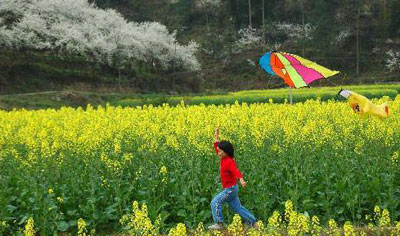
Spring is a time to fly a kite. Get to know some basics about kites before sending them up.
Tracing history
The first known kite entered the skies in fourth century BC. Made entirely of wood and fashioned like an eagle, the kite was constructed by the Confucian philosopher and hermit Mo Zi, who lived on Mount Lu in modern-day Shandong Province.
Kites developed during the Warring States Period (475-221 BC) and were designed as tools of war for reconnaissance, relaying information and measuring distance. Some kites actually carried bundles of gunpowder.
By Tang Dynasty (618-907), kites left the hands of generals and entered the hands of well-to-do children. Kites soon became associated with the Tomb Sweeping Festival. While the festival traditionally focused on the sweeping of ancestral tombs and the offering of money and food to the dead, it also celebrated the coming of spring. The festival, still celebrated today, occurs in the first week of April ?perfect for kite enthusiasts.
Types of Kites
There are three types of traditional kites commonly flown in China. The first type is the hard-wing kite, because the wings are reinforced on both the front and the back, forming a stiff wing capable of flying at high altitudes. These kites often take the shapes of swallows, eagles or other birds.
The second type is the soft-wing. It is not reinforced and flutters freely in the wind. Typical shapes include butterflies, dragonflies and fish. All similarities end once the kites are in the air, however.
The third type of kite is the dragon or centipede kite, which has a long body composed of dozens of segments connected by strands of twine. Unlike the two other kites, getting the dragon kite in the air requires special skill. This is because the most decorated part of the kite, the dragon head, doesn’t aid in its flight ╥t’s purely ornamental. The kite is flown segment-by-segment, tail first, and only after the entire body is in flight is te dragon head attached.
Selected places
Kite enthusiasts love to fly kites in and around Beijing at the following eight sites.
Tian’anmen Squar
Tian’anmen Square may be the most spacious and popular place to fly a kit. It is a bright and beautiful scene when the sky is dotted with kites on a clear day. Keep your distance from the flagpole and the national flag.
Getting there: By subway line 1 to Tian’anmen East or WestTemple of Heaven
The temple has a spacious white marble passage between the Hall of Prayer for Good Harvests and the Circular Mound Altar. It is one of the best places to fly a kite. Get out of the way when tourists pass through.
Getting there: there are many buses to the four gates of the Temple of Heaven, such as bus 17, 20, 54, 106, 116 or 120
Chaoyang Park
The park is a popular place to fly a kite. Many people meet up on a stretch of lawn to the north to fly kites. The trees are not tall and space is ample.
Getting there: By buses 731, 831, 815, 758, 834 or 988
China Millennium Monument
The area in the China Millennium Monument is expansive and the trees are sparse. Do not tread on the grass while flying your kite.
Getting there: By subway line 1 to the Military Museum
Shijingshan Amusement Park
There are many entertainment projects in Shijingshan Amusement Park. The open space before the park is a good spot to fly a kite. It is close to the road, so be careful. At the center of the square there is a fountain. Be careful not to slip.
Getting there: By subway line 1 and get off at Bajiao Youleyuan, or by buses 337, 327, 325, 354, 385 or 728
Qinglong Lake
The Qinglong Lake is located between the Fengtai and Fangshan district of Beijing. It is a beautiful area covered in grass and flowers.
Getting there: By 917 Fangshan direct line, get off at Liangxiang Beiguan and change No 6 minibus to Qinglong Lake
Yangtai Mountain
Fly a kite on the the summit of Yangtai Mountain, located in Haidian district. There is a valley between Yangtai Mountian and Fenghuang Mountain that gets excellent breezes for kite flying.
Getting there: By 346 bus at East Gate of the Summer Palace and get off at Beianhe Bei Kou.
Mang Mountain
The Mang Mountain is located in the northeast of the Shisanling, or Thirteen Tombs, Reservoir. The ground is smooth and spacious, and the air is fresh. Enjoy a wonderful view of green water and groups of wild ducks when you fly a kite.
Getting there: By 912 bus at Andingmen, or 845 bus at Xizhimen and get off at Shisanling Reservoir.
Flying a kite was once a “traditional ceremony” to greet each spring in the capital. Old residents may still remember the colorful kites in Changdian and one exquisite kite named “Shayaner.”fly a kite in Spring time is the best way to shake hands with the wind, relax and enjoy the sunshine.
(bjtoday.ynet.com April 11, 2008)